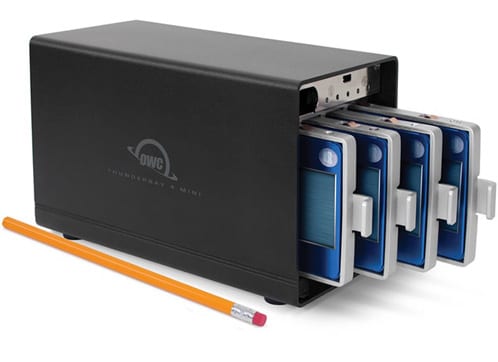
When it comes to choosing an external enclosure to house an SSD or hard drive, there are so many options that it can be difficult not only to make a decision, but also to figure out just how many possibilities are available.
One approach that can help in organizing the choices is to think about which enclosure type is best suited to your expansion needs. We’re going to organize our look at external enclosures by the type of connection and the enclosure’s capabilities, and then provide a brief look at what some of the likely types of uses such storage expansion would be used for.
We’re going to concentrate on bare or “diskless” enclosures that you can place one or more SSDs in, but the general information can also be used to help select an enclosure for any type of supported storage device, including hard drives, SATA-based SSDs, PCIe-based SSD blades, or even optical drives, to access your collection of DVDs. You can also apply this information to purchasing external storage systems that come with drives already installed.
Enclosures can hold a single drive, multiple drives, multiple drives with built-in RAID, and multiple drives of different sizes. Enclosures can have additional functions beyond just housing a storage drive; some perform as port multipliers or docks, allowing one interface to be used to provide connectivity through multiple port types.
You may need a storage enclosure for optimizing speed, or an inexpensive way to create that backup system you’ve been promising yourself. Either way, you should find some helpful information in our guide to picking an external enclosure.
Best Use for Thunderbolt Enclosures
The Thunderbolt interface is certainly versatile. Depending on the Thunderbolt version available on your Mac, it can provide data throughput of up to 40 Gbps (Thunderbolt 3), 20 Gbps (Thunderbolt 2), or 10 Gbps (Thunderbolt 1 or just plain Thunderbolt).
But it isn’t just the raw speed available in Thunderbolt that makes it a great choice for storage and other uses; it also has the ability to support multiple interface specifications. Thunderbolt 3 supports 40 Gbps data transfer speeds, USB 3.1 Gen2 running at 10 Gbps, and DisplayPort 1.2, with support for two 4K streams, and the ability to provide up to 15 watts of power for bus-powered devices, or 100 watts for charging, all wrapped up in a single USB-C connector.
When selecting a Thunderbolt 3 enclosure for storage, you have a few basic types to choose from: a Thunderbolt Dock, such as the OWC Thunderbolt 3 Dock (see image below), which allows you to connect a single cable to your Mac to break out multiple USB 3.1 ports, a mini DisplayPort supporting dual 4K displays, or a 5K display and an HD display, S/PDIF digital audio, a card reader, even a legacy FireWire 800 port.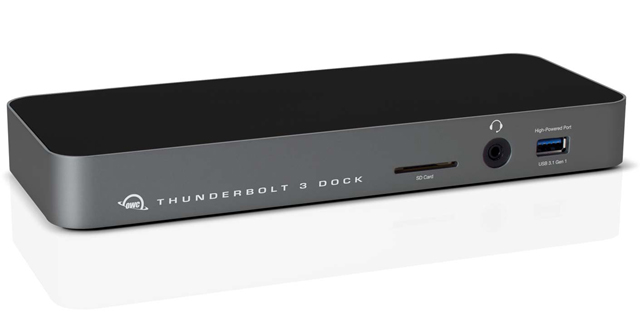 Docks are available in various port configurations, but since we’re concentrating on storage, they allow you to use additional USB 3 Gen1 or Gen2 ports to attach additional storage enclosures to. Pretty helpful when you find your Mac’s ports are all in use.
Docks are available in various port configurations, but since we’re concentrating on storage, they allow you to use additional USB 3 Gen1 or Gen2 ports to attach additional storage enclosures to. Pretty helpful when you find your Mac’s ports are all in use.
But we’re just getting started with Thunderbolt’s versatility. Enclosures are available that provide a PCIe-based expansion chassis, such as the Mercury Helios 3 (see image below). The PCIe interface can be used to install various types of PCIe expansion cards, but for storage, a PCIe card that accepts one or more SSD blades will provide for a screamingly fast storage system. Or, if you already have a few SATA SSDs, you can install them in a high-performance SATA to PCIe card and gain a bit more performance from them than you can get out of a USB 3 interface.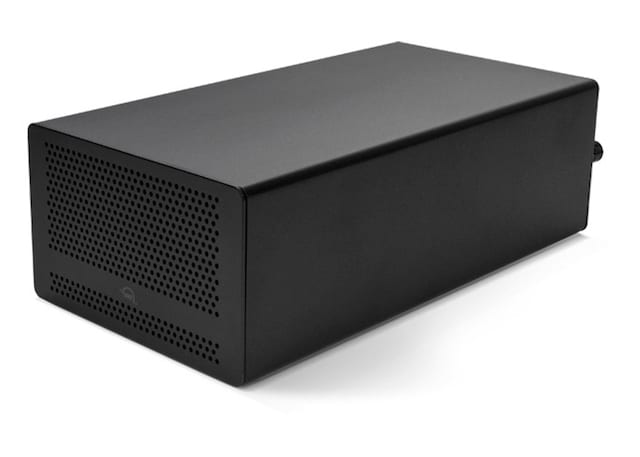 The final Thunderbolt storage option, and the one that is most familiar, is a dedicated enclosure that uses the SATA interface internally to connect to SSDs, hard drives, or optical devices.
The final Thunderbolt storage option, and the one that is most familiar, is a dedicated enclosure that uses the SATA interface internally to connect to SSDs, hard drives, or optical devices.
You’ll find Thunderbolt storage enclosures available in single drive configurations, multi-drive configurations, and multi-drive configurations with built-in hardware-based RAID. RAID can be used to enhance performance or provide a check against data loss caused by drive failure. RAID can even do both, increasing speed while protecting data against drive failure.
Related: How RAID 0, SoftRAID Can Help You Get Fastest Speeds Possible for Your Mac
With all the versatility and performance they offer, Thunderbolt-based enclosures lend themselves to hobbyists and professionals looking to maximize performance, either by using Thunderbolt-based storage for high-speed access to image, video, or music libraries to feed high-performance editing systems, or to enhance their Mac’s overall performance by providing a faster startup drive than was available at the time their Mac was purchased.
With the use of a RAID-based Thunderbolt enclosure, both speed and data integrity can be optimized, a key feature for many media professionals.
Thunderbolt 3 enclosures also provide a bit of future proofing for those of us with older Macs who are looking for a storage solution that will work today on Macs equipped with Thunderbolt, as well as on future Macs we may be considering.
Thunderbolt-based enclosures and expansion chassis tend to be on the expensive side compared to other storage options, but their raw speed and ability to meet demanding needs more than justify the cost.
Speed at a Lower Cost: USB 3.1 Gen2
When you want to improve performance but don’t need high-end data throughput, or high-end costs, USB 3.1 Gen2 enclosures may be just what you’re looking for.
USB 3.1 Gen2 offers speeds up to 10 Gbps; that’s twice as fast as USB 3 and on par with the original Thunderbolt speeds. Even better, USB 3.1 Gen2 storage enclosures are available for only a slight premium versus equivalent USB 3 enclosures.
USB 3.1 Gen2 storage solutions are available in single drive, dual bay RAID enclosures, such as the Mercury Elite Pro Dual mini (see image below) with RAID 0, 1, Span, Independent, and 4-bay models that support a few additional RAID levels.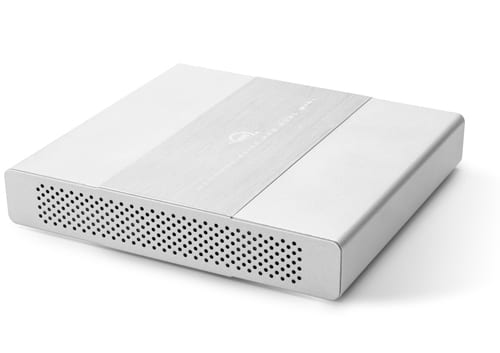 USB 3.1 Gen2 storage systems will appeal to those who need higher performance than what is available from USB 3 or USB 3.1 Gen1. A single SATA-based SSD in a Gen2 enclosure isn’t limited by the enclosure interface, releasing the full performance available. In a dual bay RAID with two SATA SSDs in a RAID 0, you’ll see an increase in performance, though you’ll bump up against the enclosure’s bandwidth limits. Even so, the relatively low cost of these enclosures makes them a great choice for hobbyists and prosumers in multimedia endeavors. They’re also a good choice for anyone just looking to gain some general performance from an external storage system, and they can be used as boot devices for older Macs with internal hard drives.
USB 3.1 Gen2 storage systems will appeal to those who need higher performance than what is available from USB 3 or USB 3.1 Gen1. A single SATA-based SSD in a Gen2 enclosure isn’t limited by the enclosure interface, releasing the full performance available. In a dual bay RAID with two SATA SSDs in a RAID 0, you’ll see an increase in performance, though you’ll bump up against the enclosure’s bandwidth limits. Even so, the relatively low cost of these enclosures makes them a great choice for hobbyists and prosumers in multimedia endeavors. They’re also a good choice for anyone just looking to gain some general performance from an external storage system, and they can be used as boot devices for older Macs with internal hard drives.
You also pick up a bit of future proofing, ensuring that a Mac you may be eyeing later, with its USB-C type connectors and higher performance Gen2 ports, will be able to make use of the enclosure you buy today.
USB 3.1 Gen2 enclosures occupy the middle tier, both in performance and cost.
The Thrift of USB 3 and USB 3.1
What can I say? I like inexpensive. Many of the external storage systems I use every day are connected via USB 3 or USB 3 Gen1. So what’s the difference between the two? You can read more about that topic in this article: The History of USB … It’s Not Quite As Simple As 1, 2, 3. For our purposes here, we’re just going to refer to these enclosures as USB 3.
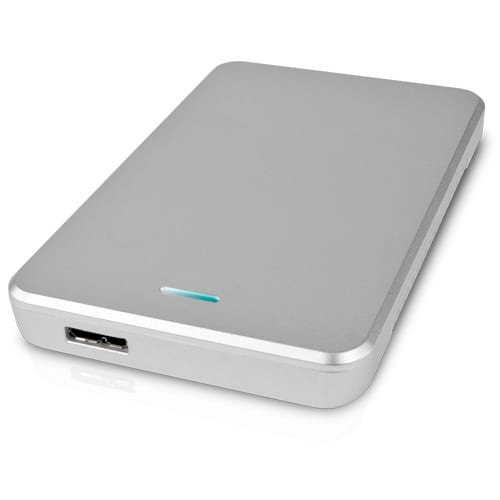 USB 3 enclosures are available in single bay and dual bay, as well as 4-bay and larger enclosures, with or without built-in hardware-based RAID. Enclosures are available that can support 3.5″ hard drives, 2.5″ SSDs, and laptop drives, as well as 5.25″ optical drives. There are also a few that can support either 3.5″ or 2.5″ drives, so you can use the enclosure with your current hard drive, or that new SSD you’re going to be picking up.
USB 3 enclosures are available in single bay and dual bay, as well as 4-bay and larger enclosures, with or without built-in hardware-based RAID. Enclosures are available that can support 3.5″ hard drives, 2.5″ SSDs, and laptop drives, as well as 5.25″ optical drives. There are also a few that can support either 3.5″ or 2.5″ drives, so you can use the enclosure with your current hard drive, or that new SSD you’re going to be picking up.
Some of the least expensive storage enclosures are available in this category, such as the bus-powered OWC Express line of enclosures. While we’ve been looking exclusively at empty enclosures that you add your own drives to, the same is true of ready-made external drives. The single bay bus-powered USB 3 configuration is usually the least expensive external drive option available.
USB 3 enclosures may be ideal for many uses, such as backup, including using one or more for your Time Machine backups. Bus-powered models are easy to take with you, ensuring that at least one backup method travels with you. They’re also useful if you need to move a backup or any type of externally stored data around to multiple computers; just eject, unplug, and carry to the next Mac where it’s needed.
The main limit on the use of a USB 3 enclosure is its theoretical 5 Gbps interface. Real-world speed would be a bit lower, but in any case, the transfer speed is slightly lower than what a SATA-based SSD can theoretically provide, meaning the USB 3 interface will be a bit of a bottleneck to performance, at least for SSDs. For rotational hard drives and optical drives, the bottleneck remains at the drive and not the interface. So, you’ll get full performance out of any hard drive or optical drive you install in a USB 3 enclosure.
USB 3 is a great choice for adding general-purpose storage. It can be used by hobbyists and prosumers to store large libraries of data, such as music and images, externally to a Mac, keeping its internal startup drive from filling up and slowing down performance.
USB 3 also makes a handy interface for a drive dock, a system for quickly swapping out one drive for another. Drive docks essentially let you connect a 3.5″ drive or a 2.5″ drive to your Mac without having to use any type of tools; just plug in and go. They’re designed to be used for temporary access to data you may have archived on a drive. They’re also handy for formatting, testing, and duplicating content on a drive.
USB 3 enclosures are a bargain hunter’s best friend. They can provide outstanding value; just be aware of the performance limits.









I bought Sabrent with USAP support for my Evo 850 and it works well. Additionally, I use this SSD as bootable external drive. Speed of the drive in enclosure is very close to original speed.
I bought the Apple adapter to use my old Thunderbolt 1 RAID with my new MacBook Pro. I was going to get a new Thunderbay from OWC, but you can’t. The ship time is listed as 36 days. Wonder if they’re finally coming out with TB3 Thunderbays…be nice if they could clarify that. It’s not like they’d lose any sales – we can’t buy one currently!
I have three Thunderbay 4 enclosures and planning to get more. How will I connect them to a Thunderbolt 3 port on a Mac other than by a Apple adapter? Are you planning to make Thunderbays with both Thunderbolt 2 and Thunderbolt 3 ports? Then I could link it to my older Thinderbays.
Hi, George. We can’t comment on future product releases here. We recommend using the Apple adapter for the connection, which can be found here: https://eshop.macsales.com/item/Apple/MMEL2AMA/. If you have any other questions, please feel free to contact our customer support team.
I’m having some issues with kernel panics with my TB4 + Apple adapter & High Sierra. (iMac 18.3 Radeon Pro 580 8GB, 24 GB Ram (OWC))
The issue has since disappeared when running Amphetamine along with the Drive alive option enabled. I’m assuming there is a sleep issue and legacy TB devices connected via adapter.
I don’t have TB3 enclosure to test with yet so this is specific to TB2 + Apple adapter. May also be machine specific as I have the newer iMac.
keep UP the fine work y’all have been doing over the past years THX Y’all‼️ will be back • Alan♿️
When is OWC (MacSales) bringing 4TB SSD with Thunderbolt 3 (40 Gbps) and USB 3.1 Type-C Generation 2 (10 Gbps)? Check out the current gold standards: Samsung 960 Pro (internal but can be used as external with enclosure, as JMR and Sonnet do) and Samsung Portable SSD T5.